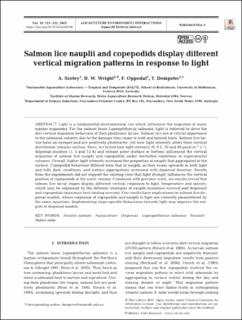| dc.description.abstract | Light is a fundamental environmental cue which influences the migration of many marine organisms. For the salmon louse Lepeophtheirus salmonis, light is believed to drive the diel vertical migration behaviour of their planktonic larvae. Salmon lice are of critical importance to the salmonid industry due to the damage they cause to wild and farmed hosts. Salmon lice larvae have an eyespot and are positively phototactic, yet how light intensity alters their vertical distribution remains unclear. Here, we tested how light intensity (0, 0.5, 10 and 80 µmol m-2 s-1), dispersal duration (1, 4 and 12 h) and release point (surface or bottom) influenced the vertical migration of salmon lice nauplii and copepodids under controlled conditions in experimental columns. Overall, higher light intensity increased the proportion of nauplii that aggregated at the surface. Copepodid behaviour differed from that of nauplii, as they swam upwards in both light and fully dark conditions, and surface aggregations increased with dispersal duration. Results from the experiments did not support the existing view that light strongly influences the vertical position of copepodids in the water column. Combined with previous work, our results reveal that salmon lice larval stages display different vertical responses to light, temperature and salinity, which may be explained by the different strategies of nauplii (maximise survival and dispersal) and copepodids (maximise host-finding success). Our results have implications for salmon lice dispersal models, where responses of copepodids and nauplii to light are currently parametrised by the same equations. Implementing stage-specific behaviours towards light may improve the outputs of dispersal models. | en_US |
